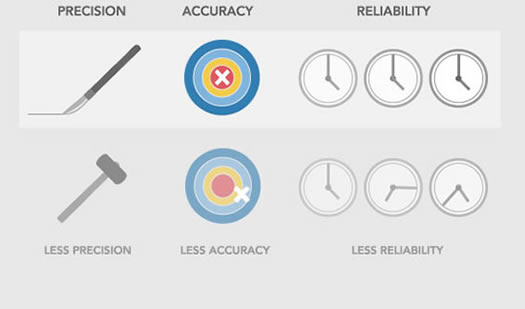Quickly & Easily Measure the Effects of Fatigue
The PVT (Psychomotor Vigilance Test) is a gold standard measure of behavioral alertness and attention. The PVT has been extensively validated to be sensitive to the affects of fatigue and medical conditions. It works because it is unaffected by learning effects and aptitude differences. It requires no training. Over 150 peer review scientific studies have confirmed the validity of the PVT. Available now for the iPad and iPad mini from Joggle Research.
PVT Measures Changes in:
- psychomotor speed
- lapses of attention
- instability of alertness
- impulsivity induced by fatigue
- other performance degrading factors
PVT Works Because:
- over 150 peer-reviewed scientific studies have
confirmed the utility of the PVT - requires no training
- not confounded by learning effects
- unaffected by aptitude differences
Better Behavioral Alertness Assay
Equals Better Research
Statistical power in a research study is directly related to the precision, accuracy and reliability of the assay. Our PVT technology has been validated in laboratory experiments, field studies, and FDA-approved clinical drug trials as a sensitive assay of behavioral alertness.
Our Superior Technology Delivers Precision, Accuracy and Reliability
Responding to a NASA need for an accurate, zero up-mass, PVT for astronauts we collaborated with the University of Pennsylvania to develop a software only version that could be performed accurately on the International Space Station.
Using our proprietary PACE™ (Performance Assessment Calibration Engine) system we are able to transform any laptop into a high precision cognitive performance testing apparatus.

Introducing the New Briefer 3-Minute PVT
The briefer 3-minute PVT provides a practical method to assess performance in operational environments.
The 3-minute PVT is more than just a shorter PVT. It is optimized to provide maximal sensitivity with minimal error.
(Basner & Dinges 2011)
The sensitivity of the 3-minute PVT has been validated in controlled laboratory experiments on total sleep deprivation (N=31) and chronic partial sleep deprivation (N=43).
(Basner, Mollicone, & Dinges In Prep)
The History of the PVT
The PVT (Psychomotor Vigilance Test) was invented by Dr. David F. Dinges to measure changes in psychomotor speed, lapses of attention, instability of alertness, and impulsivity induced by fatigue, and other performance-degrading factors. Research supported by NIH, DOD, DOT, DHS, NASA as well as the pharmaceutical industry, has extensively validated the PVT to be sensitive to a variety of performance-degrading fatigue-related factors.
Studies supported by NIH helped establish the sensitivity of PVT performance to acute total and chronic partial sleep deprivation, duration of recovery sleep and recycle. DOT studies used the PVT to identify the most sensitive and reliable sensor technologies for monitoring truck driver fatigue. Studies supported by the AFOSR established the changes that occur in the brain that are reflected during degraded PVT performance.
AFOSR and FDA-approved studies supported by the pharmaceutical industry used the PVT to determine the benefits of various wake-promoting drugs on performance. DHS studies demonstrated that PVT performance was a predictor of performance on a simulated threat detection task.
FAQ
What does the PVT measure?
The PVT measures your behavioral alertness and the stability of your vigilant attention by tracking lapses of attention, slow responses and impulsivity (false starts).
Why are behavioral alertness and attention important?
All cognition requires attention. If you cannot sustain attention you cannot perform any task that requires your brain.
Why is precision needed with the PVT?
The accuracy of a scientific measurement is only as good as it's precision and reliability. Accuracy allows the test to have maximal sensitivity with minimal error. Measurement devices with substantial timing error (smartphone apps, web-based apps) can produce less accurate PVT measurements. These inaccuracies are generally not apparent to the tester.
Peer-Reviewed References
Comparative Utility of Instruments for Monitoring Sleepiness-Related Performance Decrements in the Operational Environment.
Journal of Sleep Research, 2004. 13: p. 219-227.
Balkin TJ, Bliese PD, Belenky G, Sing H, Thorne DR, Thomas M, Redmond DP, Russo M, and Wesensten NJ,
Final Report: Evaluation of Techniques for Ocular Measurement as an Index of Fatigue and as Ther Basis for Alertness Management.
1998.
Dinges DF, Maislin G., Powell J.W.
Psychomotor Vigilance Performance: Neurocognitive Assay Sensitive to Sleep Loss, in Sleep Deprivation Clinical Issues, Pharmacology, and Sleep Loss Effects.
C.A. Kushida, Editor. 2005, Marcel Dekker: New York. p. 39-70.
Dorrian J, Rogers NL, and Dinges DF
Maximizing Sensitivity of the Psychomotor Vigilance Test (PVT) to Sleep Loss
SLEEP, Vol. 34, No. 5, 2011
Basner M, Dinges, DF
Validity and sensitivity of a brief psychomotor vigilance test (PVT-B) to total and partial sleep deprivation
Acta Astronautica 69 (2011) 949–959
Basner M, Mollicone D, Dinges, DF
The Neural Basis of The Psychomotor Vigilance Task.
Sleep, 2005. 28(9): p. 1059-1068.
Drummond SPA, Bischoff-Grethe A, Dinges DF, Ayalon L, Mednick SC, and Meloy MJ
Sleep Deprivation and Vigilant Attention, In Molecular and Biophysical Mechanisms of Arousal, Alertness, and Attention.
2008, Blackwell Publishing: Oxford. p. 305-322.
Lim JL and Dinges DF
The Cumulative Cost of Additional Wakefulness: Dose-response Effects On Neurobehavioral Functions and Sleep Physiology From Chronic Sleep Restriction and Total Sleep Deprivation.
Sleep, 2003. 26(2): p. 117-126
Van Dongen HPA, Maislin G, Mullington JM, and Dinges DF
A 3-Minute Version of the Psychomotor Vigilance Test Predicts Fatigue-Related Declines in Luggage-Screening Performance
JOEM Volume 53, Number 10, October 2011
Basner M, Rubinstein J